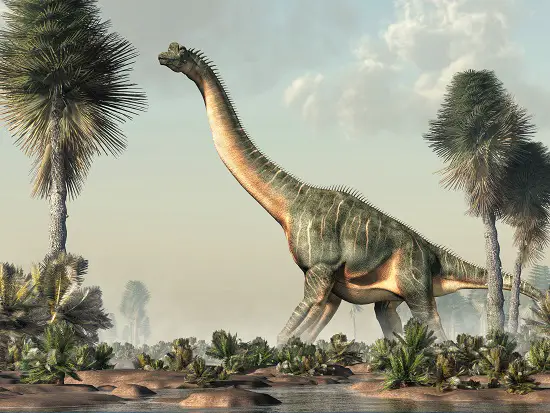How Much Did A Brachiosaurus Weigh?
Ever since its appearance in Jurassic Park 30 years ago the Brachiosaurus has been the subject of endless fascination and study. A true giant both big and tall. However there has been many debates throughout the years around how much did a Brachiosaurus weigh.
The weight of a Brachiosaurus, one of the largest dinosaurs, is estimated to be between 30 to 45 tons. These estimates are based on advanced methodologies such as volumetric analysis and computer modeling, and while exact figures may vary, this range is most widely accepted by scientists.
So if those are the current estimates of how much the Brachiosaurus would have weighed if would be helpful to know how that number was worked out.
We take a look at the weight of a Brachiosaurus, how they estimate this and some comparisons to more familiar items to truly understand how much a Brachiosaurs could weigh in the article below.

Overview of the Brachiosaurus
Belonging to the sauropods group, and one of the most famous members, the Brachiosaurus was one of the largest dinosaurs to walk the Earth during the Late Jurassic period.
Its most distinguishable features include its long neck, small skull, and disproportionally large forelimbs, contributing to its name which translates to “arm lizard”.
Discovered in 1900 by Elmer S. Riggs, the Brachiosaurus has since played a significant role in paleontology, reshaping our perception of dinosaur size and structure.
Despite the scarcity of complete fossils, scientists have made significant strides in reconstructing this incredible creature.
Its enormous size naturally prompts the question: how much did the Brachiosaurus weigh?
How To Estimate Dinosaur Weight
Estimating the weight of an extinct creature from millions of years ago is no small task, but as time has gone by scientists have used more and more innovative methods to tackle this complex puzzle.
- One approach is comparative anatomy, which involves comparing dinosaur bones with those of modern animals. This is where some of the earlier estimates of the weight of Brachiosaurus and other dinosaurs come from. While it has merits, it needs to be paired with other methods to help with accuracy.
- Another is volumetric analysis and techniques which – simply put for all of us – estimate weight based on the animal’s estimated volume.
- Then there’s the method of scaling laws, using mathematical models based on size and weight ratios of modern animals.
- In the digital age, computer modeling is also applied, providing a more dynamic visualization of the dinosaur’s possible body mass.
Each method, while innovative, presents its own challenges and limitations.
Current Estimates of Brachiosaurus’ Weight
Recent research attempts to converge on a more precise estimate of the Brachiosaurus’ weight, applying cutting-edge techniques and technologies.
Today, many paleontologists favor a weight range between 30-45 tons, considering the advancements in volumetric analysis and computer modeling and comparing it to the similar sized Giraffatitan which has more fossils to study. This is where the 23 to 40+ or so tons weight comes from. (Sources here)
While there remains a pretty wide range between estimates, these variations show how difficult it is to work out this data from fossils and (educated) guess work.

Brachiosaurs Weight Comparison
With such huge weight, and remember that Brachiosaurus was by no means the largest of the long necked sauropod dinosaurs, it can be difficult to understand actually how large and heavy this dinosaur actually was.
We have tried to make this a little easier to understand how heavy the Brachiosaurus was with the table below.
In this table we compare with some more familiar items like dogs, cats and even people, and hopefully from this you can definitely start to agree it is one dinosaur you never want standing on your toes!
Table 1: Brachiosaurus Weight Comparison
| Object/Animal | Estimated Average Weight (lbs) | Equivalent to a 66,138 lbs (30-ton) Brachiosaurus | Equivalent to a 99,208 lbs (45-ton) Brachiosaurus |
|---|---|---|---|
| House Cat | 9.9 | 6,683 cats | 10,025 cats |
| Dime (coin) | 0.005 | 13,227,600,000 dimes | 19,841,400,000 dimes |
| Watermelon | 20 | 3,307 watermelons | 4,960 watermelons |
| Four-seater Car | 3,307 | 20 cars | 30 cars |
| Elephant | 13,228 | 5 elephants | 7.5 elephants |
| Human (avg. adult) | 137 | 483 humans | 724 humans |
| Mobile Phone | 0.38 | 174,047,368 phones | 261,071,052 phones |
| Labrador Dog | 66 | 1,002dogs | 1,503, dogs |
| Giraffe | 2,628 | 25, giraffes | 37, giraffes |
| Grand Piano | 882 | 75 pianos | 112 pianos |
| Hippo | 3,307 | 20 hippos | 30 hippos |
| Blue Whale | 299,828 | 0.22 whales | 0.33 whales |
Previous Estimates for Brachiosaurus Weight
Early calculations in the 20th century proposed an astonishing weight of up to 80-85 tons, suggesting that the Brachiosaurus was one of the heaviest dinosaurs ever known.
These estimates were based primarily on comparative anatomy, using modern large animals as the benchmark.
However, these early estimates were criticized for potential inaccuracies, as these methods could overestimate the mass of extinct creatures -clearly!
As methodologies advanced, especially with the advent of volumetric analysis and computer modeling, estimates started to trend downward.
For example, in 2009, a study by Mike Taylor used a detailed volumetric approach and proposed a more modest estimate of 23 tons for the Brachiosaurus / Giraffatitan.
That is quite a difference between 80 to 23 tons for a Brachiosaurus, and this discrepancy highlighted not only the challenges of estimating dinosaur weight, but also the need for further research and refinement of methodologies.
How Heavy was a Brachiosaurus tail?
Estimating the weight of specific parts of a Brachiosaurus is quite challenging due to the lack of complete fossils and the variations in dinosaur body proportions.
Also, the weight distribution in living organisms is not uniform and depends on factors such as bone density, muscle mass, and fat distribution, which are hard to determine from fossil records.
However, JUST FOR FUN! we can attempt some rough estimates based on the proportion of these parts to the whole body.
Here are some approximate estimates:
- Leg: Considering the legs of the Brachiosaurus were massive and supportive, they could constitute around 15% of its total weight. Thus, each leg of a 30-ton Brachiosaurus could weigh around 4.5 tons (or 9,000 lbs), and for a 45-ton individual, around 6.75 tons (or 13,500 lbs).
- Head: The Brachiosaurus had a relatively small head compared to its body, possibly making up around 1% of its total weight. This would make the head of a 30-ton Brachiosaurus about 0.3 tons (or 600 lbs), and for a 45-ton individual, about 0.45 tons (or 900 lbs).
- Tail: The tail of the Brachiosaurus was long and muscular, likely accounting for around 15% of its total weight. So, the tail of a 30-ton Brachiosaurus could weigh around 4.5 tons (or 9,000 lbs), and for a 45-ton individual, around 6.75 tons (or 13,500 lbs).
Remember, these are very rough estimates and actual weights could vary based on numerous factors.
Why is it important to learn about Brachiosaurus’ Weight
The Brachiosaurus’ weight is more than just an interesting trivia fact – it has the potential to give us insights into the creature’s behavior, biomechanics, and ecological role.
An animal’s weight has a direct bearing on its mobility, diet, and lifestyle.
For instance, the Brachiosaurus’ enormous mass would have required substantial energy, suggesting a diet of copious amounts of plant matter.
Its weight could also have influenced its ability to migrate and interact with its environment.
Understanding the Brachiosaurus’ weight contributes to broader knowledge about all sauropod biomechanics and physiology and helps all of us learn more about our prehistoric past.
Conclusion
While estimates may vary, recent studies suggest a range between 30 to 45 tons, or 60 – 90,000 lbs. as the weight of a Brachiosaurus. Though there have been estimates as high has 80 tons or more and all the way down to 23 tons.
Whatever the extract weight is at the time of writing, or at you time of reading this article, we can be sure Brachiosaurus was one of the giants of the dinosaur world, both in real life and in popular culture.
References
- https://www.zoo.org/document.doc?id=302#:~:text=Brachiosaurus
- https://kids.nationalgeographic.com/animals/prehistoric/facts/brachiosaurus
- https://en.wikipedia.org/wiki/Brachiosaurus
- https://study.com/academy/lesson/brachiosaurus-facts-size-weight.html
- https://www.researchgate.net/publication/316519353_Body_mass_estimation_in_paleontology_A_review_of_volumetric_techniques
- https://www.tandfonline.com/doi/abs/10.1671/0272-4634%282001%29021%5B0051%3AANMTCA%5D2.0.CO%3B2
Hi, I am Roy Ford a General Studies and English Teacher who has taught all over the world. What started as a fossil collection became a great way to teach, motivate and inspire students of all ages and all over the world about dinosaurs and from that and children’s love of dinosaurs came the site dinosaur facts for kids, a resource for all ages.






